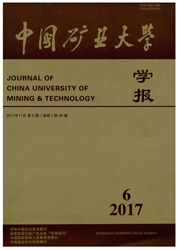

 中文摘要:
中文摘要:
由于双重孔隙结构的存在,溶液毛细作用与重力流共同存在于浸堆内。毛细作用是细颗粒矿石和内部粗糙岩石溶解的主要原因。通过一系列柱浸实验探究了粒径和堆体孔隙率对毛细管过程的影响。证实堆体内存在大孔隙,并且依此提出毛细上升理论。柱浸实验使用两组矿石颗粒,即单一粒径颗粒与非均匀颗粒。研究结果表明:颗粒大小与毛细管最终高度成反比,并且颗粒越小,毛细上升越高。颗粒分级程度较低时,毛细上升高度和速度较小,然而颗粒分级程度较高时毛细上升高度和速度较大。获得了孔隙度和毛细上升的拟合参数之间的关系。柱浸颗粒较细时低孔隙度和高表面张力导致更高的毛细高度。毛细管水分含量随毛细上升高度增加而增加,并获得了毛细管高度和水分含量之间的关系。
 英文摘要:
英文摘要:
The capillary process coexists with gravity flow within leaching heap due to the dual-porosity structure. Capillary rise is responsible for the mineral dissolution in fine particle zones and interior coarse rock. The effect of particle size and heap porosity on the capillary process was investigated through a series of column tests. Macropore of the ore heap was identified, and its capillary rise theory analysis was put forward. Two groups of ore particles, mono-size and non-uniform, were selected for the capillary rise test. The result shows that particle size has an inverse effect on the capillary ultimate height, and smaller particles exhibit higher capillary rise. Meanwhile, the poorly graded group exhibits small rise height and velocity, while the capillary rise in the well-graded particles is much greater. The relationship between porosity and fitting parameters of capillary rise was obtained. Low porosity and high surface tension lead to higher capillary height of the fine gradation. Moisture content increases with the capillary rise level going up, the relationship between capillary height and moisture content was obtained.
 同期刊论文项目
同期刊论文项目
 同项目期刊论文
同项目期刊论文
 期刊信息
期刊信息
